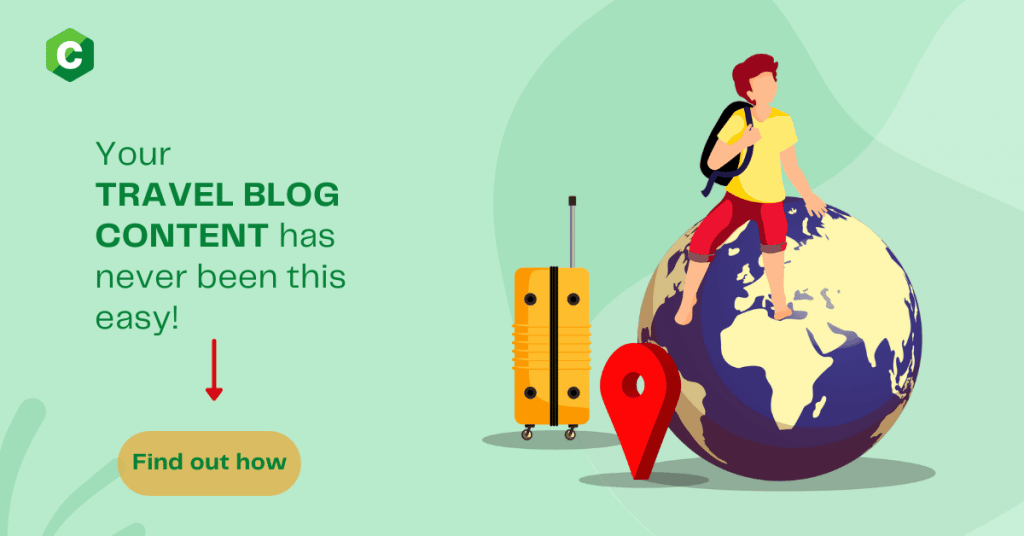Have you ever dreamed of getting paid to see the world? Well understanding how to start a travel blog from scratch and diving into travel blogging may just be the career for you. As a professional travel blogger, you get to document your journeys, photos, and destination guides. You also get to share personal recommendations on your website and social media. But how do you break into this niche, and is it actually profitable?
First off, starting a successful travel blog is relatively easy and affordable – all you need is a domain name and hosting service. The biggest hurdle new bloggers face is building an audience. However, consistency and networking are key to attracting readers and brands. And yes, travel blogging can definitely be lucrative. As a professional travel blogger, you can easily make six figures through sponsored campaigns and affiliate links. But even if your blog doesn’t bring in tons of income, the experiences gained from traveling the world are valuable enough on their own.
Therefore, let’s dive right into understanding the nitty-gritty of starting a travel blog so you can start this beautiful journey!
How To Start A Travel Blog (The Steps)
So you want to start a travel blog? Great idea! It’s not just about sharing your adventures with friends and family. Successful travel blogs can also lead to networking opportunities and monetization options. But before you start hitting that publish button, there are some crucial steps you’ll want to take first. These are as follows:
Identify a niche
If you’re thinking about starting a travel blog, it’s important to first identify your niche. Many new bloggers make the mistake of trying to cover too many different types of travel. But it’s easier for readers to connect with and follow blog posts that have a specific focus. Plus, being known as an expert in one particular type of travel can also lead to opportunities for sponsored trips and collaborations. But how do you choose a niche?
As with any creative project, the best bet is to go with something that genuinely interests and excites you. Some popular niches in the world of travel blogging include budget traveling, luxury experiences, solo female travel, LGBT+ focused travels, sustainability and eco-travel, food and culture, adventure sports, and family travel. When choosing your niche, think about what sets you apart from all the other travel blogs out there. What unique perspective or experience can you bring to the table?
Define your brand
As you focus on understanding how to start a travel blog, it’s important to first define your brand and determine your unique angle. Are you focusing on budget travel? Luxury vacation destinations? Off-the-beaten-path adventures? This doesn’t have to be set in stone – your brand can evolve over time. But having something clear in mind will help attract the right audience and give direction for future content creation.
Defining your brand also helps establish consistency in graphics and language, creating a recognizable aesthetic that resonates with readers. One way to do this is by creating a mood board or inspiration board, filled with images, quotes, and words that capture the essence of your brand. You can also analyze successful blogs within your niche and identify common themes or elements.
Pick a blog and domain name
Choosing a travel blog name may seem like a minor task, but it can actually have a big impact on the success of your blog. Your blog name is often the first impression that potential readers will have when they come across your site. An interesting or memorable name can make all the difference in standing out in a sea of other travel blogs. In addition, having a well-chosen name can also make your website easier to find through search engines.
So what should you consider when selecting a travel blog name? One important aspect is ensuring that the domain is available – nothing looks more unprofessional than having a hyphenated or made-up version of your desired domain. It’s also helpful to choose a name that reflects the tone and focus of your blog.

Install WordPress and get hosting
Before you set up your website, it’s important to consider your web hosting plan options. There are many providers out there, but for professional travel bloggers, WordPress is often the go-to choice. The platform offers customizable templates and easily accessible tools for adding content like photos and articles. Plus, WordPress has built-in search engine optimization features that can help boost your blog’s visibility in search results.
However, while WordPress is a great option, there are also other services to consider. Squarespace and Wix both offer user-friendly design options, while dedicated hosting sites like Bluehost or GoDaddy provide more technical control over your website. Ultimately, as you learn how to start a travel blog, the right choice will depend on your specific needs and personal preferences as a travel blogger.
Choose a theme for your blog
In the crowded world of travel blogging, how can you make your blog stand out? One way is to choose a premium theme or niche that sets you apart from the rest. Having a theme helps potential readers quickly understand what your blog is about and allows you to provide unique, targeted content. It also allows you to connect with like-minded individuals and potentially work with specific brands or companies in your chosen niche. Of course, finding your ideal theme may take some time and experimentation. Nonetheless, there are some great premium themes you can use for your blog:
- Divi offers a range of customizable layouts and features, including spotlighting featured posts and adding social media buttons for easy sharing.
- SeedProd is known for its simple drag-and-drop page builder, making it easy for even beginners to craft unique web pages.
- Astra is optimized for speed, so visitors will have a smooth experience browsing through your blog.
- OceanWP includes stock photos that perfectly capture a traveler’s spirit.
- Neve boasts a mobile-friendly design to ensure your readers have no trouble accessing your blog on the go.
Install essential plugins
Another important step to take is installing essential plugins. These helpful tools can improve the functionality and design of your website, making it more user-friendly and visually appealing. Popular plugins include Yoast SEO, an SEO plugin, which helps optimize your website for search engines, and WPForms, which allows you to easily create contact forms. Social sharing plugins such as Instagram Feed allow readers to see your latest posts on Instagram, while also driving traffic back to your website. Don’t underestimate the power of these small additions – they can make all the difference in how successful your travel blog becomes.

Create a content plan
It’s easy to get caught up in the excitement of travel blogging and jump right into posting without a basic plan. But trust me – taking a little time upfront to strategize will benefit you in the long run. Having a clear direction for your blog will not only make it easier for you to come up with content ideas on a regular basis, but it can also help attract and retain readers who are looking for specific information. So how do you go about creating a basic plan?
First, ask yourself some important questions – what is the overall theme or focus of your blog? What do you want to share with your readers? Once you have that established, think about how often you want to publish blog posts, as well as any specific destinations or topics you want to cover. From there, brainstorm potential blog post ideas and map out a rough editorial schedule for yourself. This may seem like a lot of work at first, but it will make things much smoother in the long run and ensure you have a successful travel blog.
Create high-quality content
When it comes to creating content for a travel blog or website, the old adage “quality over quantity” rings true. As you figure out how to start a travel blog you’ll learn that high-quality travel content means accurately researching information and destinations, being engaging and informative in writing style, and including stunning photographs or videos. This shows readers that you are trustworthy and knowledgeable about your subject matter. Additionally, high-quality content is more likely to rank on search engines and drive traffic to your site.
To create this level of content you’ll need to have a clear understanding of your target audience and what they want to see. Then, invest time in researching destinations and gathering valuable insights before sharing them with readers. And finally, take stunning photographs or videos that will draw people in and make them want to visit the places you write about.
Making Money From Your Travel Blog
So, you’ve taken the time to understand how to start a travel blog and have finally started your own blog – congrats! But have you thought about how you can turn those amazing posts and photos into cold hard cash? It may seem daunting, but once you understand how the monetization process works, it’s actually quite simple. Here are a few avenues you can explore.
Google Adsense
The process of setting up an Adsense account is relatively straightforward. All you need to do is sign up and add a bit of code to your website. From there, Google will automatically display appropriate ads on your site based on the content of your blog posts. And the best part? You get paid for each click on these ads. As a travel blogger, incorporating Adsense into your revenue stream can be a great way to offset some of the expenses associated with traveling and exploring new destinations.
Affiliate Marketing
Essentially, this involves promoting a company’s products or services on your blog through affiliate links and receiving a commission for any resulting sales. As a travel blogger, there are tons of opportunities for affiliate marketing. These could be in the form of hotel and flight booking sites, rental car companies, and travel gear retailers. By partnering with these companies, you can earn passive income while also providing value to your readers by recommending deals and discounts. Plus, setting up affiliate links is fairly simple and can easily be incorporated into your blog posts.
Email Marketing
Another way to monetize your travel blog is email marketing. How does it work? Essentially, by collecting email addresses from your readers and creating an email list, you can send them promotions and offers from companies that want to reach your audience. This could include everything from hotels and airlines to clothing and gear brands.
You can also offer sponsored content in your newsletter or promote your own products and services. The key is building a strong email list of engaged subscribers who trust your recommendations. This means providing valuable, interesting content in each email and only promoting products that align with your brand values. Done correctly, email marketing can be a powerful source of income for any successful travel blogger. So start building that email list today!

Sponsored Posts
The beauty of sponsored posts is that they allow you to make money while also showcasing products or destinations that align with the theme and content of your blog. Plus, it’s an easy way to make passive income. All you have to do is write the post and hit publish. How do you start getting sponsored post opportunities? One strategy is to establish relationships with tourism boards, hotels, and travel brands in the places you visit. Another option is to join blogger networks and apply for sponsored campaigns through their platform. So if you’re looking for ways to make money, consider adding sponsored posts to your repertoire!
Sponsored Trips
Sponsored trips are a great way for you to earn money while exploring the world. By partnering with companies or destinations, you can receive free or discounted trips in exchange for promoting them on your blog and social media channels. Plus, as your blog grows in popularity, you may also attract opportunities for sponsored content or partnerships with hotels, airlines, and tour companies. So, as you learn how to start a travel blog and make money from it, make sure your blog offers valuable information to readers so that you’re able to connect with brands.
Network With Other Bloggers
When networking, we often think about how it can benefit us in terms of job opportunities or personal connections. But networking within your industry can also lead to great business opportunities. Other bloggers might be looking for someone to collaborate with on sponsored posts or sponsored trips. They could also offer affiliate marketing opportunities or even recommend your services to their own networks. But how do you actually network with other bloggers? The best way is to reach out and introduce yourself through social media or email, attend relevant events and conferences, and join blog-specific Facebook groups or forums where fellow bloggers congregate online.

Final Thoughts
So there you have it – a comprehensive guide on how to start a travel blog and make money from it. It can be as simple or complex as you want to make it, but with a little effort and some help from the right people, you could create a successful blog and generate passive income for years to come.
Additionally, our travel blogging service is designed to help bloggers just like you take their blogs to new heights! From creating content that engages readers to incorporating SEO techniques that will boost your traffic, we’ve got everything you need to set yourself up for success. Contact us today!
Thanks for reading and happy blogging!
More often than not, travel bloggers make money by creating sponsored content and getting paid to go on trips.
You should start a blog if you’re looking to educate and inspire and are passionate about travel. If you’re a topical or destination expert you can help people maximize their vacation time and trip budget.
Yes, you can, in fact, maintain a travel blog even when you’re not traveling. But it does take some solid experience, a lot of determination, and quite a bit of creativity.

